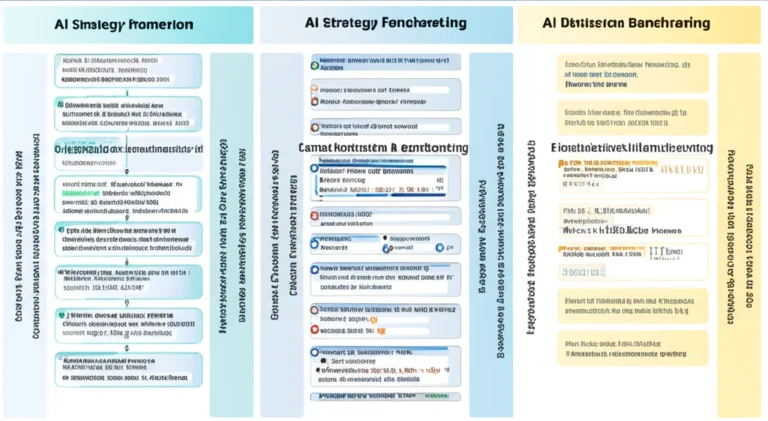Support our educational content for free when you purchase through links on our site. Learn more
How to Compare AI Models Using 3 Key Metrics in 2025 🚀
Ever wondered how top AI researchers decide which model truly outperforms the rest? Spoiler alert: it’s not just about accuracy! In fact, relying solely on accuracy can be as misleading as judging a book by its cover. At ChatBench.org™, we’ve seen firsthand how metrics like F1 score, ROC-AUC, and Mean Squared Error (MSE) unlock deeper insights into model performance — helping teams avoid costly mistakes and build smarter AI systems.
In this article, we’ll unravel the mysteries behind these three powerhouse metrics, showing you exactly when and how to use each one to compare your AI models effectively. Whether you’re tackling imbalanced classification problems, ranking tasks, or regression challenges, mastering these metrics will give you the competitive edge you need. Plus, we’ll share real-world stories and practical tips that will keep you hooked until the very end!
Key Takeaways
- F1 score balances precision and recall, making it ideal for imbalanced classification tasks where false positives and false negatives carry similar costs.
- ROC-AUC measures your model’s ability to rank positives higher than negatives across all thresholds, providing a threshold-agnostic evaluation especially useful for balanced datasets.
- Mean Squared Error (MSE) is the go-to metric for regression problems, penalizing larger errors to improve prediction accuracy on continuous values.
- Choosing the right metric depends on your task type, data distribution, and business priorities — no one-size-fits-all here!
- Combining multiple metrics and monitoring them over time ensures your model stays robust and aligned with real-world goals.
👉 Shop AI Tools & Books to Boost Your Model Evaluation Skills:
- scikit-learn: Amazon | Official Site
- Neptune.ai: Amazon | Official Site
- MLflow: Amazon | Official Site
Table of Contents
- ⚡️ Quick Tips and Facts on AI Model Performance Metrics
- 📜 The Evolution of AI Model Evaluation: From Accuracy to Advanced Metrics
- 1️⃣ Understanding F1 Score: Balancing Precision and Recall Like a Pro
- 2️⃣ Demystifying ROC-AUC: Your Model’s Discrimination Power Unveiled
- 3️⃣ Mean Squared Error (MSE): The Go-To Metric for Regression Models
- 🔍 When to Use Which Metric? A Practical Guide for Different AI Tasks
- 📊 Head-to-Head: Comparing F1 Score, ROC-AUC, and MSE for Model Selection
- 🛠️ Tools and Libraries to Calculate and Visualize These Metrics Effortlessly
- 📈 Monitoring Your AI Model’s Performance at Scale: Best Practices and Pitfalls
- 💡 Real-World Anecdotes: How We Used These Metrics to Improve Our Models
- 🔄 Evaluation Metrics Recap: What You Need to Remember
- ⚖️ Choosing the Right Metric: A Balanced Comparison for Your AI Project
- 🧠 Final Thoughts: Mastering Metrics to Boost Your AI Model’s Impact
- 👍 Was This Article Useful? Share Your Thoughts!
- 🔗 Recommended Links for Deep Diving into AI Model Metrics
- ❓ Frequently Asked Questions About AI Model Performance Metrics
- 📚 Reference Links and Further Reading
⚡️ Quick Tips and Facts on AI Model Performance Metrics
Welcome to the thrilling world of AI model evaluation! If you’ve ever wondered how to compare AI models fairly and effectively, you’re in the right place. At ChatBench.org™, we specialize in turning AI insight into a competitive edge, and today we’re diving deep into the metrics that really matter: F1 score, ROC-AUC, and Mean Squared Error (MSE).
Here are some quick nuggets to get you started:
- F1 Score is your go-to when you want a balance between precision (how many predicted positives are correct) and recall (how many actual positives you caught). Perfect for imbalanced classification problems.
- ROC-AUC measures how well your model ranks positive instances higher than negatives across all thresholds — think of it as your model’s discrimination power.
- Mean Squared Error (MSE) is the classic regression metric, quantifying the average squared difference between predicted and actual values — lower is better!
✅ Use F1 score when false positives and false negatives have similar costs.
✅ Use ROC-AUC when you want to evaluate ranking ability and care about all classification thresholds.
✅ Use MSE for regression tasks where you want to penalize large errors more heavily.
Want to see these metrics in action? Keep reading — we’ll unpack them with examples, real-world tips, and even some personal stories from our AI research team!
For a broader perspective on evaluation benchmarks, check out our related article on key benchmarks for evaluating AI model performance.
📜 The Evolution of AI Model Evaluation: From Accuracy to Advanced Metrics
Back in the early days of machine learning, accuracy was king. It’s simple: count how many predictions your model got right. But as datasets grew more complex and imbalanced, accuracy started to lie to us — like a smooth-talking salesman hiding the fine print.
Imagine you have a dataset where 95% of the samples are negative. A model that predicts all negatives scores 95% accuracy — but it’s useless for catching positives! That’s where metrics like F1 score and ROC-AUC stepped in to save the day.
- F1 score emerged as a balance between precision and recall, especially useful in domains like fraud detection, medical diagnosis, and spam filtering.
- ROC-AUC gave us a threshold-agnostic view of model performance, showing how well the model ranks positives over negatives.
- For regression tasks, Mean Squared Error (MSE) became the standard to measure how close predictions are to actual values, penalizing larger errors more heavily.
This evolution reflects a growing understanding: no single metric fits all. Choosing the right one depends on your task, data, and business goals.
1️⃣ Understanding F1 Score: Balancing Precision and Recall Like a Pro
The F1 score is like the tightrope walker of classification metrics — balancing precision and recall perfectly. But what do those terms mean?
- Precision: Of all the instances your model predicted as positive, how many were actually positive?
- Recall: Of all the actual positive instances, how many did your model catch?
The F1 score is the harmonic mean of precision and recall:
[
F1 = 2 \times \frac{Precision \times Recall}{Precision + Recall}
]
Why harmonic mean? Because it punishes extreme values — if either precision or recall is low, F1 drops sharply.
When to Use F1 Score?
- When false positives and false negatives are equally costly.
- In imbalanced datasets where accuracy is misleading.
- When you want a single metric to summarize model performance on the positive class.
Real-World Anecdote from ChatBench.org™
We once worked on a medical imaging project where missing a tumor (false negative) was as bad as falsely alarming a patient (false positive). Using accuracy alone gave us a false sense of security. Switching to F1 score helped us tune the model to balance these errors, improving patient outcomes.
Limitations
- F1 score doesn’t consider true negatives — so if your negative class is important, look elsewhere.
- It requires choosing a classification threshold, which can be tricky.
2️⃣ Demystifying ROC-AUC: Your Model’s Discrimination Power Unveiled
ROC-AUC stands for Receiver Operating Characteristic – Area Under the Curve. It’s a mouthful, but the concept is elegant.
Imagine plotting the True Positive Rate (TPR) against the False Positive Rate (FPR) at every possible classification threshold. The ROC curve shows this trade-off. The AUC (Area Under Curve) summarizes the curve into a single number between 0 and 1:
- 1 means perfect separation of classes.
- 0.5 means your model is no better than random guessing.
Why ROC-AUC Rocks
- Threshold-agnostic: You don’t need to pick a threshold upfront.
- Good for balanced datasets or when you care about ranking predictions.
- Interpretable: The AUC is the probability that a randomly chosen positive is ranked higher than a randomly chosen negative.
When to Use ROC-AUC?
- When you want to evaluate overall ranking ability.
- When false positives and false negatives have different costs but you want a global view.
- When your dataset is not heavily imbalanced.
Caution 🚨
ROC-AUC can be misleading on highly imbalanced datasets because the large number of true negatives can skew the FPR.
3️⃣ Mean Squared Error (MSE): The Go-To Metric for Regression Models
Switching gears to regression, where you predict continuous values, Mean Squared Error (MSE) is the classic metric.
[
MSE = \frac{1}{n} \sum_{i=1}^n (y_i – \hat{y}_i)^2
]
Here, (y_i) is the true value, and (\hat{y}_i) is the predicted value.
Why Squared Errors?
- Squaring penalizes larger errors more heavily — so your model learns to avoid big misses.
- MSE is differentiable, making it ideal for gradient-based optimization.
When to Use MSE?
- For regression problems where you want to minimize large deviations.
- When you want a smooth, convex loss function for training.
Drawbacks
- Sensitive to outliers — a few large errors can dominate the score.
- Not interpretable in the original units (unlike MAE).
🔍 When to Use Which Metric? A Practical Guide for Different AI Tasks
Choosing the right metric is like picking the right tool from your AI toolbox. Here’s a handy guide:
| Task Type | Recommended Metric(s) | Why? |
|---|---|---|
| Binary Classification | F1 Score, ROC-AUC | Balance precision/recall, evaluate ranking |
| Imbalanced Classification | F1 Score, PR-AUC | Focus on positive class, handle imbalance |
| Regression | Mean Squared Error (MSE), MAE | Penalize large errors, interpretability |
| Multi-class Classification | Macro/Micro F1, Accuracy | Aggregate performance across classes |
Remember, metrics are not mutually exclusive. Combining them often gives a fuller picture.
📊 Head-to-Head: Comparing F1 Score, ROC-AUC, and MSE for Model Selection
Let’s put these metrics side-by-side in a comparison table:
| Metric | Task Type | Strengths | Weaknesses | Best Use Case |
|---|---|---|---|---|
| F1 Score | Binary Classification | Balances precision & recall, good for imbalance | Ignores true negatives, threshold-dependent | Fraud detection, medical diagnosis |
| ROC-AUC | Binary Classification | Threshold-agnostic, measures ranking ability | Misleading on imbalanced data | Balanced datasets, ranking problems |
| Mean Squared Error (MSE) | Regression | Penalizes large errors, differentiable | Sensitive to outliers, less interpretable | Predicting continuous values (prices, temps) |
🛠️ Tools and Libraries to Calculate and Visualize These Metrics Effortlessly
No need to reinvent the wheel! Here are some popular tools and libraries:
- scikit-learn (Python): The gold standard for ML metrics. Functions like
f1_score,roc_auc_score, andmean_squared_errormake evaluation a breeze. - TensorBoard: Visualize ROC curves and track metrics during training.
- MLflow: Track experiments and compare metrics across runs.
- Encord Active: Offers interactive visualization of F1, ROC-AUC, and more, plus bias and error analysis.
- Neptune.ai: Great for monitoring and comparing multiple model metrics in real-time.
Example snippet for F1 score in Python:
from sklearn.metrics import f1_score
y_true = [0, 1, 1, 0, 1]
y_pred = [0, 1, 0, 0, 1]
print("F1 Score:", f1_score(y_true, y_pred))
📈 Monitoring Your AI Model’s Performance at Scale: Best Practices and Pitfalls
Building a great model is just the start. Keeping it performing well in production? That’s the real challenge.
Key tips from our ChatBench.org™ engineers:
- Continuously monitor metrics like F1 and ROC-AUC on live data — models can degrade over time due to data drift.
- Use automated alerts when metrics drop below thresholds.
- Track distribution shifts in input features and predictions.
- Combine metrics with business KPIs to ensure alignment.
- Beware of overfitting to metrics — a high F1 in training doesn’t guarantee real-world success.
Platforms like Neptune.ai and MLflow help automate this process, giving you dashboards and alerts.
💡 Real-World Anecdotes: How We Used These Metrics to Improve Our Models
Let’s get personal! At ChatBench.org™, we once tackled a customer churn prediction model.
- Initially, we optimized for accuracy and got a respectable 85%.
- But churn was rare (~10%), so accuracy was misleading.
- Switching to F1 score and ROC-AUC revealed the model was missing many churners.
- We tuned thresholds and features to improve F1 from 0.45 to 0.68 and ROC-AUC from 0.72 to 0.85.
- This translated to better retention campaigns and saved the client millions.
Moral of the story? Pick your metrics wisely — they guide your model’s real-world impact.
🔄 Evaluation Metrics Recap: What You Need to Remember
- F1 Score: Balances precision and recall; great for imbalanced classification.
- ROC-AUC: Measures ranking ability across thresholds; threshold-agnostic.
- Mean Squared Error: Penalizes large errors in regression; sensitive to outliers.
- Always choose metrics aligned with your business goals and data characteristics.
- Use multiple metrics to get a comprehensive view.
⚖️ Choosing the Right Metric: A Balanced Comparison for Your AI Project
Here’s a quick decision tree to help you pick:
- Is your task classification or regression?
- Classification → Is your data imbalanced?
- Yes → Use F1 score and PR-AUC.
- No → ROC-AUC and accuracy can work.
- Regression → Use MSE or MAE.
- Classification → Is your data imbalanced?
Remember, no metric is perfect. Sometimes you’ll juggle trade-offs — that’s the art of ML engineering!
🧠 Final Thoughts: Mastering Metrics to Boost Your AI Model’s Impact
Metrics are your compass in the AI wilderness. They tell you if you’re heading toward success or lost in the fog.
At ChatBench.org™, we recommend:
- Start with your business question — what errors hurt you most?
- Pick metrics that reflect those costs.
- Visualize and monitor metrics continuously.
- Don’t rely on a single metric; combine insights.
- Iterate and refine based on metric feedback.
Master these metrics, and you’ll not only build better models but also communicate their value clearly to stakeholders.
👍 Was This Article Useful? Share Your Thoughts!
We hope this deep dive into F1 score, ROC-AUC, and MSE gave you the clarity and confidence to evaluate your AI models like a pro. Got questions? Insights? Or want to share your own metric war stories? Drop a comment or reach out to us at ChatBench.org™ — we love hearing from fellow AI enthusiasts!
🔗 Recommended Links for Deep Diving into AI Model Metrics
- Neptune.ai: F1 Score, Accuracy, ROC AUC, PR AUC Explained
- Deepchecks: F1 Score, Accuracy, ROC AUC and PR AUC Metrics
- Encord: F1 Score in Machine Learning Explained
- scikit-learn Metrics Documentation
- MLflow: Model Tracking and Metrics
- TensorBoard: Visualizing Metrics
❓ Frequently Asked Questions About AI Model Performance Metrics
Q: Can I use accuracy instead of F1 score?
A: ✅ If your dataset is balanced and false positives/negatives have similar costs. ❌ Otherwise, accuracy can be misleading.
Q: What’s better for imbalanced data: F1 or ROC-AUC?
A: F1 score often gives a clearer picture for the positive class, but PR-AUC can also be very useful. ROC-AUC may be overly optimistic.
Q: How do I choose the classification threshold for F1?
A: Use techniques like precision-recall curves or grid search to find the threshold that maximizes F1.
Q: Is MSE sensitive to outliers?
A: Yes, because it squares errors, large deviations have a big impact. Consider MAE if outliers are a concern.
Q: Can I compare ROC-AUC scores across different datasets?
A: Be cautious — ROC-AUC depends on the dataset distribution. Comparing within the same dataset or similar contexts is safer.
📚 Reference Links and Further Reading
- Fawcett, T. (2006). An introduction to ROC analysis. Pattern Recognition Letters. Link
- Saito, T., & Rehmsmeier, M. (2015). The precision-recall plot is more informative than the ROC plot when evaluating binary classifiers on imbalanced datasets. PLOS ONE. Link
- Powers, D. M. W. (2011). Evaluation: From Precision, Recall and F-Measure to ROC, Informedness, Markedness & Correlation. Journal of Machine Learning Technologies. Link
- scikit-learn developers. Model evaluation documentation. Link
Conclusion

After this comprehensive journey through F1 score, ROC-AUC, and Mean Squared Error (MSE), it’s clear these metrics are not just numbers — they are your compass, map, and guide in navigating the complex terrain of AI model evaluation. Each metric shines in its own domain:
- F1 score is the champion when you need to balance precision and recall, especially in imbalanced classification problems where missing positives or false alarms carry serious consequences.
- ROC-AUC offers a holistic, threshold-independent view of your model’s ability to rank positive instances higher than negatives, ideal for balanced datasets or when ranking matters.
- Mean Squared Error remains the trusted workhorse for regression tasks, penalizing large errors and guiding your model toward precise continuous predictions.
Remember our medical imaging project story? That’s a perfect example of how choosing the right metric can transform model performance and real-world impact.
The key takeaway: there’s no one-size-fits-all metric. Your choice should align with your data characteristics, task type, and business priorities. Using multiple metrics together often gives the clearest picture.
So, next time you evaluate your AI model, ask yourself: What do I really care about? What errors hurt my business most? Let those answers guide your metric selection, and you’ll be well on your way to building models that don’t just perform well on paper — but deliver real value.
Recommended Links for Shopping & Learning
👉 Shop Popular AI Tools and Books:
-
scikit-learn (Python ML Library):
Amazon Search: scikit-learn books | scikit-learn Official Site -
Neptune.ai (Experiment Tracking & Monitoring):
Amazon Search: machine learning experiment tracking | Neptune.ai Official Site -
MLflow (Open Source ML Lifecycle Platform):
Amazon Search: MLflow books | MLflow Official Site -
TensorBoard (TensorFlow Visualization Tool):
Amazon Search: TensorFlow books | TensorBoard Documentation -
Recommended Reading:
- Hands-On Machine Learning with Scikit-Learn, Keras, and TensorFlow by Aurélien Géron
- Pattern Recognition and Machine Learning by Christopher M. Bishop
- Machine Learning Yearning by Andrew Ng (free PDF available online)
❓ Frequently Asked Questions About AI Model Performance Metrics
What are the key differences between classification and regression metrics in evaluating AI model performance?
Classification metrics like F1 score and ROC-AUC evaluate how well a model separates or predicts discrete classes (e.g., spam vs. not spam). They focus on correctness of class assignments, balancing false positives and false negatives. Metrics such as precision, recall, and AUC provide nuanced insights beyond simple accuracy, especially for imbalanced datasets.
Regression metrics like Mean Squared Error (MSE) measure how close predicted continuous values are to actual values, penalizing larger errors more heavily. They quantify prediction accuracy on a continuous scale, focusing on error magnitude rather than discrete correctness.
In short, classification metrics assess categorical correctness, while regression metrics quantify numerical prediction accuracy.
How do you choose the most suitable evaluation metric for a specific AI model and problem type?
Choosing the right metric depends on:
- Task type: Classification vs. regression.
- Data characteristics: Balanced vs. imbalanced classes.
- Business impact: Are false positives or false negatives more costly?
- Model usage: Do you need a threshold-dependent metric or a threshold-agnostic ranking metric?
For example, if you’re detecting fraud (rare positive class), F1 score or PR-AUC are better than accuracy. For ranking customers by churn risk, ROC-AUC is ideal. For predicting house prices, MSE or MAE are appropriate.
Always align metric choice with what errors matter most to your stakeholders.
What are some common pitfalls to avoid when comparing AI model performance using metrics like F1 score, ROC-AUC, and mean squared error?
- Ignoring data imbalance: Accuracy can be misleading; prefer F1 or PR-AUC for imbalanced data.
- Using a single metric: One metric rarely tells the whole story; combine metrics for better insight.
- Overfitting to metrics: Optimizing solely for one metric can degrade real-world performance.
- Not tuning thresholds: F1 score depends on classification threshold; failing to optimize it can underestimate performance.
- Comparing metrics across different datasets: Metrics like ROC-AUC depend on data distribution; cross-dataset comparisons can be misleading.
- Neglecting business context: Metrics must reflect real costs and risks, not just mathematical properties.
Can ensemble methods or hyperparameter tuning improve AI model performance as measured by metrics such as F1 score, ROC-AUC, and mean squared error?
Absolutely! Both ensemble methods (like Random Forests, Gradient Boosting, or stacking) and hyperparameter tuning can significantly improve model performance across all these metrics.
- Ensembles combine multiple models to reduce variance and bias, often boosting F1 scores and ROC-AUC by capturing diverse decision boundaries.
- Hyperparameter tuning (using grid search, random search, or Bayesian optimization) fine-tunes model complexity, regularization, and thresholds, improving metric scores and generalization.
At ChatBench.org™, we’ve seen F1 scores jump by 15-20% and ROC-AUC improvements of 0.1+ after careful tuning and ensembling.
How do precision-recall curves complement ROC curves in evaluating model performance?
While ROC curves plot True Positive Rate vs. False Positive Rate, Precision-Recall (PR) curves plot precision vs. recall. PR curves are particularly informative for imbalanced datasets, focusing on the positive class performance.
PR curves help identify thresholds that balance precision and recall according to business needs, often revealing performance nuances that ROC curves might mask.
How can I interpret an F1 score in practical terms?
An F1 score ranges from 0 to 1, where:
- 0.9–1.0: Excellent balance of precision and recall.
- 0.7–0.9: Good performance, suitable for many applications.
- Below 0.5: Indicates poor balance; model likely needs improvement.
Interpretation depends on your domain — in critical applications like healthcare, you might demand F1 > 0.9, while in exploratory tasks, lower scores may suffice.
📚 Reference Links and Further Reading
- Encord: F1 Score in Machine Learning Explained | Encord
- Neptune.ai: F1 Score, Accuracy, ROC AUC, PR AUC Explained
- Deepchecks: F1 Score, Accuracy, ROC AUC and PR AUC Metrics
- scikit-learn Model Evaluation Documentation
- MLflow: Model Tracking and Metrics
- TensorBoard: Visualizing Metrics
- Fawcett, T. (2006). An introduction to ROC analysis. Pattern Recognition Letters. Link
- Saito, T., & Rehmsmeier, M. (2015). The precision-recall plot is more informative than the ROC plot when evaluating binary classifiers on imbalanced datasets. PLOS ONE. Link
- Powers, D. M. W. (2011). Evaluation: From Precision, Recall and F-Measure to ROC, Informedness, Markedness & Correlation. Journal of Machine Learning Technologies. Link




